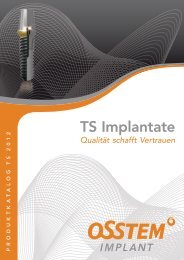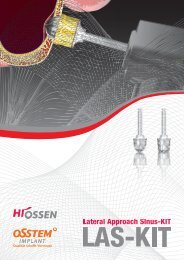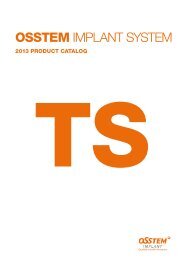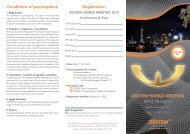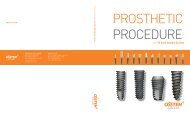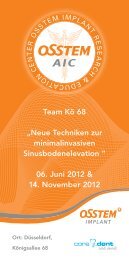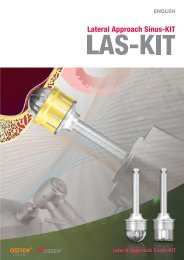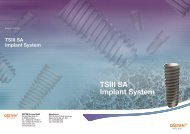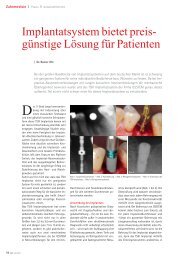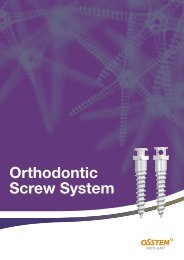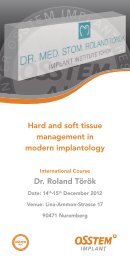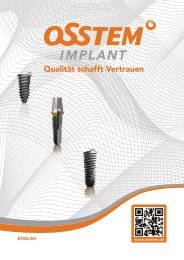A Comparison of Implant Stability Quotients Measured Using Magnetic Resonance FrequencyAnalysis from Two Directions: Prospective Clinical Study during the Initial Healing PeriodNon-submerged type Implant Stability Analysis during InitialHealing Period by Resonance Frequency AnalysisJong-Chul Park, Hyun-Duck Kim, Soung-Min Kim, Myung-Jin Kim, Jong-Ho LeeClin. Oral Impl. Res. 2010;21(6):591-7Deug-Han Kim, Eun-Kyoung Pang, Chang-Sung Kim, Seong-Ho Choi, Kyoo-Sung ChoJ Korean Acad Periodontol 2009;39(3):339-48Objectives:Results:There were no differences between the two ISQs whenmeasured from different directions, but there weresignificant differences between the higher and lowervalues of the ISQs at each measurement point. Asignificant difference was also observed between the twoISQ variation groups in the pattern of change of the lowervalue for the period from immediately after surgery to 10weeks after surgery.Objectives:The purpose of the present study was to analyze theimplant stability quotient(ISQ) values for Korean nonsubmergedtype implant and determine the factors thataffect implant stability.Results:The lowest mean stability measurement was at 3 weeks.There was significant difference between implantplacement and 12 weeks. There was significant differencebetween implant placement and 12 weeks in diameters of4.1 mm and 4.8 mm. Also, there were significantdifferences between diameters of 4.1 mm and 4.8 mm atimplant placement and 12 weeks after surgery. This resultsuggests that the factor related to implant diameter mayaffect the level of implant stability. No statisticallysignificant relationship was found between the resonancefrequency analysis and the variables of maxilla/mandible,sex, anterior/posterior, implant length, age of patient, graftperforming, bone type, insertion torque during initialhealing period.SS <strong>System</strong> Clinical StudyGiven that the orientation of the transducer (mesiodistal orbuccolingual) affects the data obtained from a piezoelectricresonance frequency analysis (RFA), this study evaluatedwhether it is necessary to use measurements taken in twodifferent directions (mesiodistal and buccolingual) whenusing magnetic RFA to assess changes in the stiffness ofdental implants.Study design:A prospective clinical trial was completed, in a total of 53patients, on 71 non-submerged dental implants that wereinserted to replace the unilateral loss of mandibular molars.All of the implants were of the same diameter (4.1 mm),length (10 mm), and collar height (2.8 mm). The implantstability quotient (ISQ) was measured during the surgicalprocedure, and at 4 and 10 weeks after surgery.Measurements were taken twice in each direction: in thebuccolingual direction from the buccal side and in themesiodistal direction from the mesial side. The average oftwo measurements in each direction was regarded as therepresentative ISQ of that direction. The higher and lowervalues of the two ISQs (buccolingual and mesiodistal) werealso classified separately. In addition, the variation in ISQwas quantified by subtracting the lower value from thehigher value, and the implants were classified into twogroups according to this variation: one with ISQ variation of3 or more and the other with a variation of 0.05Sex 0.9918 > 0.05Anterior/Posterior 0.8408 > 0.05Length 0.6317 > 0.05Diameter 0.0092 < 0.05Age 0.3836 > 0.05Graft 0.9635 > 0.05Bone type 0.8354 > 0.05Insertion torque 0.0675 > 0.05SS <strong>System</strong> Clinical StudyTable 1. The change in implant stability quotient (ISQ) discrepancymeasured from two different directions at each measurementtime pointDiameter ISQ discrepancy* (mean SD) P-value**Straumann (N=25)During surgeryAt post-operative week 10<strong>Osstem</strong> SS II (N=28)During surgeryAt post-operative week 101.1 ± 2.720.42 ± 1.480.36 ± 3.6-0.14 ± 1.540.160.317Fig. 1. The comparison of the pattern of change in the implant stabilityquotient (ISQs) obtained from the four measures from surgeryto 10 weeks after surgery.3+Group=the group with ISQ variation of 3 or more.3-Group, the group with ISQ variation of
Evaluation of Peri-implant Tissue in Nonsubmerged DentalImplants: a Multicenter Retrospective StudyA Randomized Clinical One-year Trial Comparing Two Typesof Non-submerged Dental ImplantYoung-Kyun Kim, Su-Gwan Kim, Hee-Kyun Oh, Yong-Geun Choi, Yong-Seok Cho, Young-Hak Oh, Jun-Sik SonOral Surg Oral Med Oral Pathol Oral Radiol Endod. 2009;108(2):189-95Jong-Chul Park, Seung-Ryong Ha, Soung-Min Kim, Myung-Jin Kim, Jai-Bong Lee, Jong-Ho LeeAccepted in 2009 for Publication in Clin Oral Impl ResSS <strong>System</strong> Clinical StudyObjectives:The objective of this study was to evaluate the periimplant’shard and soft tissue response associated with the1-stage, nonsubmerged, endosseous dental implant.Study design:A multicenter retrospective clinical evaluation wasperformed on 339 nonsubmerged implants placed in 108patients at 5 clinical centers between January 2003 andDecember 2007.Fig. 1. Periapical radiograph taken immediately after implant placement. Inthe #36 area, an implant, 4.8 mm in diameter and 10 mm in length,was placed. The crestal bone level in the vicinity of implant wasconsidered as the baseline.Results:After a mean follow-up period of 30 months, the meancrestal bone resorption in 339 implants was 0.43 mm. Thesurvival and success rates were observed to be 99.1% and95.1%, respectively. The mean calculus, inflammatory, andplaque indices were 0.13, 0.37, and 0.73, respectively, andthe mean width of buccal keratinized mucosa wasobserved to be 2.43 mm.Conclusions:The short- to intermediate-term evaluation of the 1-stage,nonsubmerged, endosseous implant yields relatively highsurvival and success rates.Table 1. Crestal bone resorptionBone resorptionNo. of implantsNone 1980.1~0.5 mm 100.6~1.0 mm 811.1~2.0 mm 7~2.0 mm 8Total 304**Not specified for 35 implants.Table 2. Implant failure and survival by yearYearNo. implantsat start of yearNo. implants survivalat follow-upFailuresSurvival,%1 339 336 3 99.12 336 336 0 1003 336 336 0 100Objectives:This study compared the implant stability and clinicaloutcomes obtained with two types of non-submergeddental implant that have different thread designs andsurface treatments.Materials & Methods:A randomized clinical trial with one year of follow-up wasperformed on 56 participants with 75 implants (controlgroup, 36 implants in 28 subjects; experimental group, 39implants in 28 subjects). The experimental group receivedthe <strong>Osstem</strong> SS II Implant system; the control groupreceived the Standard Straumann Dental Implant<strong>System</strong>.The diameter and length of the fixture wereuniform at 4.1 mmr and 10 mm and all the implantsrestored the unilateral loss of one or two molars from themandible. To compare implant stability, the peak insertiontorque, implant stability quotient (ISQ), and periotest value(PTV) were evaluated during surgery, and at 4 and 10weeks after surgery. To compare marginal bone loss,standard periapical radiographs were obtained duringsurgery, and at 10 weeks and one year after surgery.Table 1. Comparison of marginal bone loss between the two implantsDurationDuring the10 weeksafter surgeryType of ImplantStandard Straumann Dental Implant systemArea N Mean ± SD (mm) N Mean ± SD (mm) p value*Results:This study showed statistically significant differencesbetween the two groups in peak insertion torque (p = .009)and ISQ (p = .003) but not in PTV (p = .097) at surgery. Incontrast, there was no statistically significant difference inthe pattern of change of ISQ during the 10 weeks aftersurgery (p = .339). For marginal bone loss, no significantdifference was observed between the control andexperimental groups before functional loading (p = .624),but after one year of follow-up, a borderline difference wasnoted (p= .048).Conclusions:The success rate after one year of follow-up was 100% forboth systems of implant, despite there being significantdifference in implant stability during surgery. There was aborderline difference in marginal bone loss after one yearof follow-up.<strong>Osstem</strong> SS II Implant systemProximal 25 0.96 ± 0.64 28 0.75 ± 0.49 .273Distal 25 0.62 ± 0.44 28 0.60 ± 0.51 .722Avg 25 0.79 ± 0.51 28 0.67 ± 0.43 .624Proximal 24 1.21 ± 0.57 26 0.92 ± 0.68 .066Distal 24 0.93 ± 0.39 26 0.65 ± 0.37 .013Avg 24 1.07 ± 0.46 26 0.79 ± 0.42 .048SS <strong>System</strong> Clinical StudyFig. 2. Periapical radiograph taken 1 year after implant placement.Based on the baseline, the crestal bone level on the radiograph takenimmediately after surgery, from mesial side (a) and distal side (b), thevertical length to the first implant-bone contact area was measuredand added by referring to the magnification rate and 0.8 mm pitch, andthe average was obtained. In this case, a=0.8 mm and b=1.2 mm, andafter 1 year; the mean amount of crestal bone resorption was 1.2 mm.One yearfollow-up* The p values were calculated using Mann - Whitney test. Area means the radiographic measurement area for calculation of marginal bone loss.Avg means the average value of proximal and distal bone loss.4041



